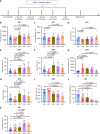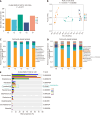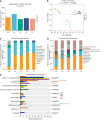Modulating oral microbiota ameliorates hypobaric hypoxia-induced anxiety- and depression-like behaviors in mice
- PMID: 40574783
- PMCID: PMC12188922
- DOI: 10.5498/wjp.v15.i6.104809
Modulating oral microbiota ameliorates hypobaric hypoxia-induced anxiety- and depression-like behaviors in mice
Abstract
Background: Hypobaric hypoxia exposure (HHE) often causes neuropsychiatric disorders. Due to its complex mechanism, efficient strategies for alleviating HHE-induced anxiety- and depression-like behaviors remain limited.
Aim: To characterize alterations in the oral and gut microbiota following HHE and to explore a potential microbiota-based intervention to mitigate associated psychiatric symptoms.
Methods: C57BL/6J mice were exposed to simulated high-altitude hypoxia (5000 m) for 1, 3, 5, or 7 days. Behavioral assessments, including the open field test, elevated plus maze, and forced swim test, were conducted to evaluate anxiety- and depression-like behaviors. Oral and fecal microbiota were analyzed using 16S rRNA sequencing to assess changes in microbial composition and diversity. Immunofluorescence staining was performed to examine c-Fos expression in brain nuclei. A probiotic formulation containing Lactobacillus rhamnosus (L. rhamnosus) DSM17648, Lactobacillus acidophilus DDS-1, and L. rhamnosus UALR-06 was administered to mice subjected to one day of HHE (HH1) to evaluate its therapeutic efficacy.
Results: Behavioral tests revealed that HHE caused anxiety- and depression-like behaviors, which were most pronounced after 1 day of exposure. The IF data revealed significantly increased expression of c-Fos in various brain nuclei after HHE, including the anterior cingulate cortex, paraventricular thalamic nucleus, lateral habenula nucleus, paraventricular hypothalamic nucleus, lateral hypothalamus, and periaqueductal gray. The 16S rRNA sequencing results demonstrated a sharp decline in the abundance of Lactobacillus in the oral microbiota of mice exposed to HH1 and a marked decrease in the abundance of Lactobacillus and Bifidobacterium in the fecal microbiota of mice exposed to three days of HHE. Finally, oral administration and gavage of Lactobacillus significantly alleviated anxiety- and depression-like behaviors in HH1 mice.
Conclusion: HHE caused significant variations in the oral and fecal microbiota of mice. Lactobacillus supplementation alleviated anxiety- and depression-like behaviors in mice. Improving oral flora may relieve HHE-induced psychiatric disorders.
Keywords: Anxiety; Depression; Fecal microbiota; Hypobaric hypoxia exposure; Lactobacillus; Oral microbiota.
©The Author(s) 2025. Published by Baishideng Publishing Group Inc. All rights reserved.
Conflict of interest statement
Conflict-of-interest statement: The author(s) report no conflict of interest in this work.
Figures







Similar articles
-
Probiotic Bifico Ameliorates Depression- and Anxiety-Like Behaviors Induced by Estrogen Deficiency via NLRP3 Inflammasome Inhibition.J Inflamm Res. 2025 Jun 20;18:8153-8171. doi: 10.2147/JIR.S511931. eCollection 2025. J Inflamm Res. 2025. PMID: 40557057 Free PMC article.
-
Research on the correlation between gut microbiota and brain cognitive function under chronic hypoxia at high altitude.Front Neurosci. 2025 Jun 19;19:1600069. doi: 10.3389/fnins.2025.1600069. eCollection 2025. Front Neurosci. 2025. PMID: 40613089 Free PMC article.
-
Effect of caloric restriction with probiotic supplementation on body composition, quality of life, and psychobiological factors of obese men: A randomized, double-blinded placebo-controlled clinical trial.Clin Nutr. 2025 Feb;45:234-249. doi: 10.1016/j.clnu.2024.12.031. Epub 2024 Dec 31. Clin Nutr. 2025. PMID: 39842252 Clinical Trial.
-
Alterations in fecal microbiota composition by probiotic supplementation in healthy adults: a systematic review of randomized controlled trials.Genome Med. 2016 May 10;8(1):52. doi: 10.1186/s13073-016-0300-5. Genome Med. 2016. PMID: 27159972 Free PMC article.
-
Oral 5-aminosalicylic acid for maintenance of remission in ulcerative colitis.Cochrane Database Syst Rev. 2016 May 9;2016(5):CD000544. doi: 10.1002/14651858.CD000544.pub4. Cochrane Database Syst Rev. 2016. Update in: Cochrane Database Syst Rev. 2020 Aug 28;8:CD000544. doi: 10.1002/14651858.CD000544.pub5. PMID: 27158764 Free PMC article. Updated.
References
-
- Bouak F, Vartanian O, Hofer K, Cheung B. Acute Mild Hypoxic Hypoxia Effects on Cognitive and Simulated Aircraft Pilot Performance. Aerosp Med Hum Perform. 2018;89:526–535. - PubMed
-
- Bardwell WA, Ensign WY, Mills PJ. Negative mood endures after completion of high-altitude military training. Ann Behav Med. 2005;29:64–69. - PubMed
LinkOut - more resources
Full Text Sources
Miscellaneous

